One of the greatest applications for drones is how they can take our eyes to places they haven't been in a while — including Pripyat, Ukraine, home of Chernobyl. Though it's been almost 30 years since the disaster, images from Pripyat continue to captivate. Both eerie and beautiful, several filmmakers have sent drones into "The Zone" to bring back footage of a place where time has stood still since the 50,000 people who called Pripyat home were forced to suddenly abandon the city after fires and explosions ripped apart two of Chernobyl's reactors and set off a deadly radiation leak. Videos began popping up weeks ago, but here is some of the most awe-inspiring footage, in case you missed it.
In honor of the footage, here are a few facts about what's happening now in "The Zone."
*According to Live Science, "The damaged reactor was hastily sealed in a concrete sarcophagus intended to contain the remaining radiation: How effective this sarcophagus has been — and will continue to be into the future — is a subject of intense scientific debate."
*The Chernobyl plant continued to operate until 2000 when the last reactor was shut down.
*The plant and most of Pripyat are still mostly considered off-limits to humans because of the radiation levels. Nevertheless, a few hundred former residents have returned to live nearby despite the radiation risks. And in 2011, Ukraine opened up the area to tourists.
*Scientists predict it won't be safe for human habitation for 20,000 years.
*But the lack of humans has made the area a sanctuary for wildlife, with thriving populations of deer, wolves, eagles and many more.
Video by Danny Cooke.




















